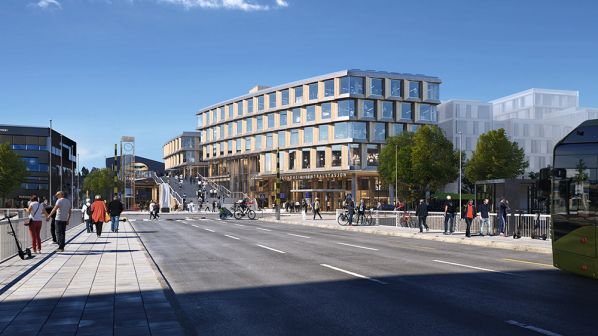NORWEGIAN infrastructure manager Bane Nor has outlined plans to invest around NKr 12bn ($US 1.7bn) in railway infrastructure in the central Trøndelag region, including NKr 2.5bn for the new Trondheim Central Station.
Trondheim, together with Oslo and Stavanger, has been selected by the European Union as part of a programme to develop 100 climate-neutral and smart cities by 2030. Redevelopment of Trondheim Central Station is a central element of these plans. The project includes the construction of a new terminal, offices, retail areas, homes, underground parking, roads and several squares and outdoor spaces.
“This will be Norway’s most modern public transport hub with associated service functions, attractive office space and the city’s best public transport services,” says Bane Nor Eiendom CEO, Mr Jon-Erik Lunøe.
The investment programme also includes the electrification of the Trondheim - Stjørdal, Hell - Riksgrensen and Stavne - Leangen lines by the end of 2024 at a cost of NKr 2.1bn, while ERTMS will be installed on the Trondheim - Melhus - Berkåk, Trondheim - Hell - Steinkjer and Hell - Storlien lines at a cost of NKr 1.3bn.
Around NKr 2.8bn will be spent on measures to increase capacity, which includes 12 sub-projects across the region to enable a half-hourly passenger service between Støren and Steinkjer. NKr 220m will be spent upgrading the Hell - Storlien line, including building new bridges and replacing old equipment.
A new workshop will be built at Støren for NKr 520m, with another NKr 140m allocated to the lines serving the depot. NKr 450m will be invested in stabling facilities at Steinkjer and Støren.
NKr 1.9bn is being invested in SJ Norway’s project to introduce 14 hybrid trains on the Lerkendal - Steinkjer Trøndelag commuter line, some of which have already entered service. To prepare for the new fleet, Bane Nor has rebuilt Steinkjer station and has modified 22 other platforms.
“We want more people to travel in a climate-friendly way by train and for a larger portion of freight traffic to run on rails,” says Bane Nor CEO, Mr Gorm Frimannslund. “Emissions must be cut and we must take better care of the environment. Therefore, a larger part of the traffic has to move from road to rail.”
Rail currently accounts for 0.1% of transport emissions in Norway, with the Norwegian government aiming to reduce transport emissions by 45% by 2030.
“The great thing about the investment in trains is that it is sustainable, and it also contributes to strengthening regional investment in Central Norway through the development of cities and towns,” Frimannslund says. “It is the result of a better, more reliable and faster train service.”

